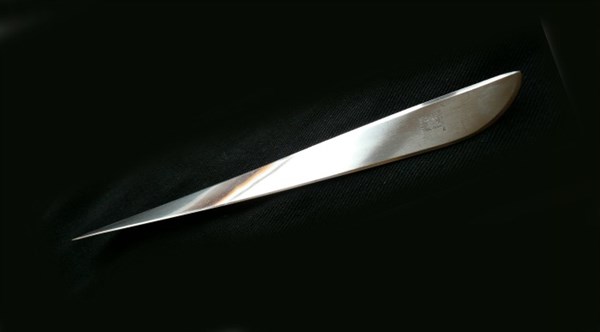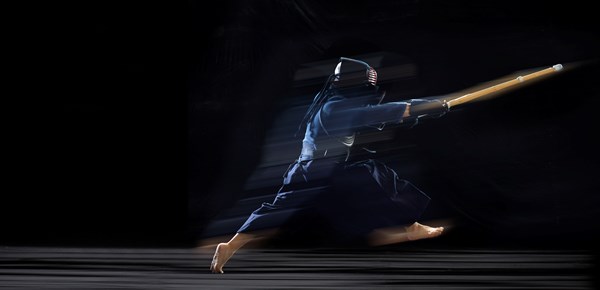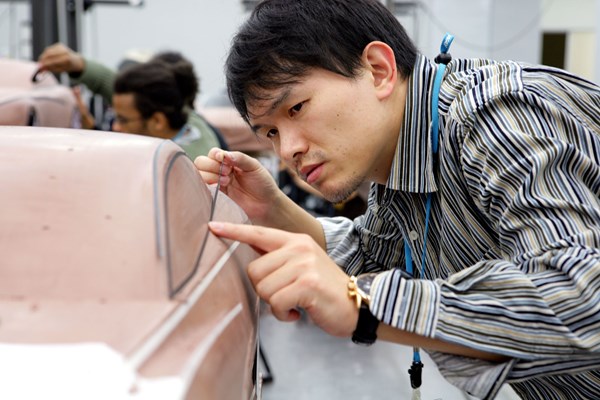This Is Shinari
The concept car is an expression of the new Mazda design language, KODO.

This is a letter opener. It was designed by Enzo Mari. When he was in high school, Ikuo Maeda’s father, Matasaburo Maeda, gave him one. Young Maeda had expressed an interest in design, so his father thought that he would give his son something that he thought was well designed. At the time, 1978, Matasaburo Maeda was leading the design team for what was to become the Mazda RX-7. Ikuo Maeda recalls of receiving the twisted piece of stain-finished stainless steel: “It felt as though I was touching something from the hands of a designer for the first time. Putting just a subtle twist in the material turns a simple blade into a functional and beautiful item. I was immediately impressed by the realization that I was holding something that had been designed well and immediately I understood what design was all about.” Fast forward 25 years. Mazda chief designer Ikuo Maeda leads the team that creates the Mazda RX-8. Clearly his father’s gift had more than a minor effect.

This is a practitioner of kendo. The Way of the Sword. “The challenge”—the challenge being presented by Ikuo Maeda to his design team: Create a vehicular representation of the design language, KODO: Soul of Motion—“for us was to create an innovative new expression for energetic and powerful movement; something that we had never attempted before. We began by developing the design around the image of a predator, as it strikes at its prey, or the stabbing movement in kendo, Japanese fencing, to express the instant where accumulated force is released,” says Yasushi Nakamuta. He led the efforts which resulted in the Mazda Shinari concept car.

This is Ikuo Maeda, Mazda’s head of Global Design. He’s been with Mazda since 1982. Listen: “My plan is to create cars that will be instantly recognizable as a Mazda, even when viewed at a distance. My ultimate goal is to create a brand presence that car lovers around the world recognize as representing both Mazda originality and Japanese originality. Future Mazdas will move people physically and emotionally.”

This is Yong Wook Cho. He designed the exterior of Shinari. He is working on the clay model of the vehicle. An interesting aspect of the development of the car. There was a design competition among designers. Yasushi Nakamuta says that there was a difference this time. Usually the designers pick the clay modelers with whom they will work. Not so with Shinari. The modelers, Nakamuta explains, are veterans compared to most of the designers. And so the modelers had the opportunity to pick the designers they’d work with. “This is very Mazda-like,” Nakamuta says. Yong Wook Cho, (who worked with Ikuo Maeda on the design of the Mazda2) is 36. He says that the designer he was partnered with was “close to 50.”

This is the interior of the Shinari. Whereas the exterior of the car was executed at the Mazda Design Strategic Studio in Yokohama, Japan, the interior was done at Mazda Design in Irvine, California. Derek Jenkins is the head of that studio. Jenkins says that when they were thinking about the person who would actually drive a Shinari, the individual was a 36-year-old freelance interior designer based in Milan, a place that Jenkins describes as “the international capital of international design.” So to accommodate the lifestyle needs of the individual, the human-machine interface (HMI) is selectable, allowing it to be set up for business, pleasure or sport. He says that they spent a lot of time creating an HMI that is informative, yet usable. The materials—like the leather—are Jenkins says, “authentic.” Jenkins spent eight years at Audi. He knows about interiors.


.jpg;width=70;height=70;mode=crop)